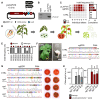RNA virus-mediated gene editing for tomato trait breeding
- PMID: 38895601
- PMCID: PMC11184526
- DOI: 10.1093/hr/uhad279
RNA virus-mediated gene editing for tomato trait breeding
Abstract
Virus-induced genome editing (VIGE) leverages viral vectors to deliver CRISPR-Cas components into plants for robust and flexible trait engineering. We describe here a VIGE approach applying an RNA viral vector based on potato virus X (PVX) for genome editing of tomato, a mayor horticultural crop. Viral delivery of single-guide RNA into Cas9-expressing lines resulted in efficient somatic editing with indel frequencies up to 58%. By proof-of-concept VIGE of PHYTOENE DESATURASE (PDS) and plant regeneration from edited somatic tissue, we recovered loss-of-function pds mutant progeny displaying an albino phenotype. VIGE of STAYGREEN 1 (SGR1), a gene involved in fruit color variation, generated sgr1 mutant lines with recolored red-brown fruits and high chlorophyll levels. The obtained editing events were heritable, overall confirming the successful breeding of fruit color. Altogether, our VIGE approach offers great potential for accelerated functional genomics of tomato variation, as well as for precision breeding of novel tomato traits.
© The Author(s) 2024. Published by Oxford University Press on behalf of Nanjing Agricultural University.
Conflict of interest statement
The authors declare no conflict of interest.
Figures

Similar articles
-
Enhancing virus-mediated genome editing for cultivated tomato through low temperature.Plant Cell Rep. 2025 Jan 6;44(1):22. doi: 10.1007/s00299-024-03392-8. Plant Cell Rep. 2025. PMID: 39762363
-
Development of virus-induced genome editing methods in Solanaceous crops.Hortic Res. 2023 Nov 17;11(1):uhad233. doi: 10.1093/hr/uhad233. eCollection 2024 Jan. Hortic Res. 2023. PMID: 38222822 Free PMC article.
-
Virus-induced systemic and heritable gene editing in pepper (Capsicum annuum L.).Plant J. 2025 Jun;122(5):e70257. doi: 10.1111/tpj.70257. Plant J. 2025. PMID: 40499557 Free PMC article.
-
Tools and targets: The dual role of plant viruses in CRISPR-Cas genome editing.Plant Genome. 2023 Jun;16(2):e20220. doi: 10.1002/tpg2.20220. Epub 2022 Jun 14. Plant Genome. 2023. PMID: 35698891 Review.
-
Beyond green and red: unlocking the genetic orchestration of tomato fruit color and pigmentation.Funct Integr Genomics. 2023 Jul 15;23(3):243. doi: 10.1007/s10142-023-01162-5. Funct Integr Genomics. 2023. PMID: 37453947 Review.
Cited by
-
Heritable virus-induced germline editing in tomato.Plant J. 2025 Apr;122(1):e70115. doi: 10.1111/tpj.70115. Plant J. 2025. PMID: 40163287 Free PMC article.
-
CRISPR-Cas9 mediated enhancement of abiotic stress resilience in tomato: a comprehensive review of target genes.Mol Biol Rep. 2025 Jun 3;52(1):538. doi: 10.1007/s11033-025-10634-9. Mol Biol Rep. 2025. PMID: 40459840 Review.
-
CRISPR-Cas systems and applications for crop bioengineering.Front Bioeng Biotechnol. 2024 Oct 16;12:1483857. doi: 10.3389/fbioe.2024.1483857. eCollection 2024. Front Bioeng Biotechnol. 2024. PMID: 39479297 Free PMC article. Review.
-
Enhancing virus-mediated genome editing for cultivated tomato through low temperature.Plant Cell Rep. 2025 Jan 6;44(1):22. doi: 10.1007/s00299-024-03392-8. Plant Cell Rep. 2025. PMID: 39762363
-
Development of an efficient and heritable virus-induced genome editing system in Solanum lycopersicum.Hortic Res. 2024 Dec 28;12(4):uhae364. doi: 10.1093/hr/uhae364. eCollection 2025 Apr. Hortic Res. 2024. PMID: 40066159 Free PMC article.
References
LinkOut - more resources
Full Text Sources
Research Materials
Miscellaneous

